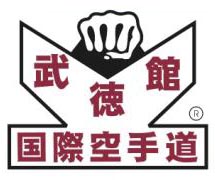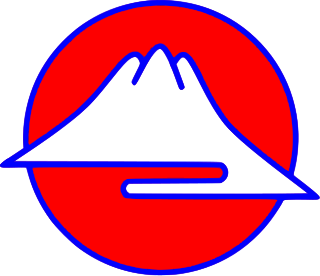Related Research Articles

Aikido is a modern Japanese martial art that is split into many different styles,including Iwama Ryu,Iwama Shin Shin Aiki Shuren Kai,Shodokan Aikido,Yoshinkan,Renshinkai,Aikikai and Ki Aikido. Aikido is now practiced in around 140 countries. It was originally developed by Morihei Ueshiba,as a synthesis of his martial studies,philosophy and religious beliefs. Ueshiba's goal was to create an art that practitioners could use to defend themselves while also protecting their attackers from injury. Aikido is often translated as "the way of unifying (with) life energy" or as "the way of harmonious spirit". According to the founder's philosophy,the primary goal in the practice of aikido is to overcome oneself instead of cultivating violence or aggressiveness. Morihei Ueshiba used the phrase masakatsu agatsu katsuhayabi" to refer to this principle.

Shotokan is a style of karate,developed from various martial arts by Gichin Funakoshi (1868–1957) and his son Gigo (Yoshitaka) Funakoshi (1906–1945). Gichin Funakoshi was born in Okinawa and is widely credited with popularizing "karate do" through a series of public demonstrations,and by promoting the development of university karate clubs,including those at Keio,Waseda,Hitotsubashi (Shodai),Takushoku,Chuo,Gakushuin,and Hosei.

Uechi-Ryū is a traditional style of Okinawan karate. Uechi-Ryūmeans "Style of Uechi" or "School of Uechi". Originally called Pangai-noon,which translates to English as "half-hard,half-soft",the style was renamed Uechi-Ryūafter the founder of the style,Kanbun Uechi,an Okinawan who went to Fuzhou in Fujian Province,China to study martial arts and Chinese medicine when he was 19 years old.

Shitō-ryū (糸東流) is a form of karate that was founded in 1934 by Kenwa Mabuni. Shitō-ryūis synthesis of the Okinawan Shuri-te and Naha-te schools of karate and today is considered one of the four main styles of the art.

In martial arts,blocking is the act of stopping or deflecting an opponent's attack for the purpose of preventing injurious contact with the body. A block usually consists of placing a limb across the line of the attack.
Gojūshiho is a kata practiced in karate. Gojushiho was developed by Sokon Matsumura,one of the key founders of Okinawan martial arts and named it "Uesheishi",which literally means 54 methods in Chinese. In some styles of karate,there are two versions of this kata - Gojūshiho Shō and Gojūshiho Dai. An advantage of the two versions of the kata is to better master the difficult techniques presented therein,but not without facing some confusion,for many sequences are the same and others only slightly different. The embusen of both Gojūshiho Shō and Gojūshiho Dai are nearly identical. Gojūshiho Shō begins straight off with a wide variety of advanced techniques and,as such,is highly recommended for study. Gojūshiho Dai consists of many advanced open-handed techniques and attacks to the collar-bone.

Gosoku-ryū (剛速流) is a style of karate which was founded by Takayuki Kubota. Gosoku stands for hard and fast,which suggests a combination of techniques both from the fast and dynamic Shōtōkan style as well as from the strength-focused Gōjū-ryūstyle.

Age-uke (上げ受け),which translates to "rising block",or "upward block" is the Japanese term for a technique used in martial arts. There numerous variations in how the technique might be executed,and nothing implicit in the term itself restricts its use to unarmed techniques. It is commonly used with regards to the Karate technique that goes by that name,but can also refer to similar techniques in Kobudo.
The Taikyoku series is a series of kata in use in several types of karate. The name Taikyoku (太極) refers to the Chinese philosophical concept of Taiji. The Taikyoku kata were developed by Yoshitaka Funakoshi and introduced by Gichin Funakoshi as a way to simplify the principles of the already simplified Pinan/Heian series. The embusen,or pattern of the kata's movements,are the same as in Heian shodan. Students of karate systems that use the Taikyoku kata series are often introduced to them first,as a preparation for the Pinan/Heian kata. GōjūKai developed five of its own Taikyoku kata,based on the Shotokan katas and retaining the I-shaped embusen. The embusen (pathway) of all the Taikyoku kata is simple:
*--! | | | | !--#

In martial arts,a knifehand strike is a strike using the part of the hand opposite the thumb,familiar to many people as a karate chop. This refers to strikes performed with the side of the knuckle of the small finger. Suitable targets for the knifehand strike include the mastoid muscles of the neck,the jugular,the throat,the collar bones,ribs,sides of the head,temple,jaw,the third vertebra,the upper arm,the wrist,the elbow,and the knee cap.
Rōhai (鷺牌) meaning “image of a heron” or “sign of a heron” is a family of kata practiced in some styles of karate. The kata originated from the Tomari-te school of Okinawan martial arts. It was called Matsumora Rōhai,after Kosaku Matsumora,who was presumably its inventor. AnkōItosu later took this kata and developed three kata from it:Rōhai shodan,Rōhai nidan,and Rōhai sandan. In Shorin-ryūand Matsubayashi-ryūthis kata introduces Gedan Shotei Ate and Ippon Ashi Dachi. It contains a sequence of Tomoe Zuki exactly the same as the one in Bassai,although the ending of the sequence chains into Hangetsu Geri/Uke.
Shorin-ryu Shidokan is the main branch of Shorin-ryūstyle of Okinawan karate,started by Katsuya Miyahira,Hanshi 10th Dan.
Enpi (燕飛),also frequently transliterated as Empi,is a kata practiced by Shotokan and other karate styles. Enpi means Flying Swallow.

Yoseikan Aikido is the aikido taught at the Yoseikan Dojo in Shizuoka,Japan,under the direction of Minoru Mochizuki.

Kenkojuku is a style of Shotokan karate previous to the establishment of the Japan Karate Association (JKA) style. It was founded by Tomosaburo Okano. Kenkojuku karate is similar to the teachings of Gichin Funakoshi and modifications made by Funakoshi´s son Yoshitaka Funakoshi. JKA Shotokan differs slightly in that it was Masatoshi Nakayama's version of Shotokan. Okano's/Yoshitaka's Kenkojuku karate and JKA karate are becoming more similar compared to other variants of Shotokan karate such as Shigeru Egami's Shotokai,Hirokazu Kanazawa's Shotokan Karate International or SKI.
Aikido techniques are frequently referred to as waza 技. Aikido training is based primarily on two partners practicing pre-arranged forms (kata) rather than freestyle practice. The basic pattern is for the receiver of the technique (uke) to initiate an attack against the person who applies the technique—the 取りtori,or shite 仕手,also referred to as (投げnage,who neutralises this attack with an aikido technique.
Karate's Nage waza is the set of techniques whereby the opponent is thrown to the ground. While typical students of karate focus most of their attention on learning striking techniques,karate throws are considered indispensable for self-defense and,although not always taught,are part of the classical art.

The Uchi-Uke refers in Karate a defense technique with the forearm for the middle part of the body (Chūdan). Uchi (内) stands for "inside",building (腕) for "arm",uke for "defense".
References
- ↑ The Karate Handbook . Internet Archive. p. 253 . Retrieved 29 December 2014.
Soto uke karate.
- ↑ Hill, Tom (16 February 2012). Karate Terminology. ISBN 9781781660461 . Retrieved 29 December 2014.
- ↑ Denwood, Chris (May 2011). Respecting the Old, Creating the New. ISBN 9781447673033 . Retrieved 29 December 2014.
- ↑ Darwish, Ali (2004). Contrast and Energy Transfer in Karate. ISBN 9780957751170 . Retrieved 29 December 2014.
- ↑ Nakamura, Tadashi (November 2001). Karate Technique & Spirit. ISBN 9780804832823 . Retrieved 29 December 2014.
- ↑ Denwood, Chris (May 2011). Respecting the Old, Creating the New. ISBN 9781447673033 . Retrieved 29 December 2014.
- ↑ Denwood, Chris (May 2011). Respecting the Old, Creating the New. ISBN 9781447673033 . Retrieved 29 December 2014.
- ↑ Yates, Keith D. (2008). The Complete Guide to American Karate & Tae Kwon Do. ISBN 9781583942154 . Retrieved 29 December 2014.